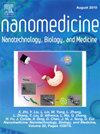Ultrasmall maghemite nanoparticles as MRI contrast agent: Unique combination of aggregation stability, low toxicity, and tumor visualization
IF 4.6
2区 医学
Q2 MEDICINE, RESEARCH & EXPERIMENTAL
Nanomedicine : nanotechnology, biology, and medicine
Pub Date : 2025-02-28
DOI:10.1016/j.nano.2025.102811
引用次数: 0
Abstract
Iron oxide nanoparticles are a promising candidate for the dual-mode MRI contrast agent, however most of them have limited circulation time and predominant negative contrast. We developed citric acid stabilized superparamagnetic maghemite nanoparticles (CA-SPMNs) with size 3.2 ± 0.7 nm with intense positive contrast. Co-precipitation reactions under well-controlled conditions in the automatic chemical reactor have carried out the synthesis. We found an encouraging correlation between aggregate formation kinetics in biological media and in vitro cytotoxicity results and in vivo circulation time. A cytotoxicity test showed the mouse fibroblast viability over 80 % for iron doses exceeding 1 mg/mL. CA-SPMNs have a low r2/r1 ratio, exhibiting positive contrast. Using in vivo MRI we demonstrated that CA-SPMNs circulate in the blood for 12–24 h, enabling blood vessel and tumor visualization, and partial renal clearance. Finally, CA-SPMNs show promise as effective MRI contrast agents, enabling differentiation between normal and pathological tissues.

超小磁赤铁矿纳米颗粒作为MRI造影剂:独特的聚集稳定性,低毒性和肿瘤可视化的组合。
氧化铁纳米颗粒是一种很有前途的双模MRI造影剂,但它们大多具有循环时间有限和主要的阴性造影剂。我们制备了柠檬酸稳定的超顺磁性磁铁矿纳米粒子(CA-SPMNs),其尺寸为3.2 ± 0.7 nm,具有强阳性对比。在控制良好的条件下,在自动化学反应器中共沉淀反应进行了合成。我们发现在生物介质中聚集形成动力学与体外细胞毒性结果和体内循环时间之间存在令人鼓舞的相关性。细胞毒性试验表明,当铁剂量超过1 mg/ml时,小鼠成纤维细胞存活率超过80% %。ca - spmn具有较低的r2/r1比值,呈阳性对比。通过体内MRI,我们证明ca - spmn在血液中循环12-24 h,使血管和肿瘤可见,并部分清除肾脏。最后,ca - spmn显示出作为有效的MRI造影剂的前景,能够区分正常和病理组织。
本文章由计算机程序翻译,如有差异,请以英文原文为准。
求助全文
约1分钟内获得全文
求助全文
来源期刊
CiteScore
11.10
自引率
0.00%
发文量
133
审稿时长
42 days
期刊介绍:
The mission of Nanomedicine: Nanotechnology, Biology, and Medicine (Nanomedicine: NBM) is to promote the emerging interdisciplinary field of nanomedicine.
Nanomedicine: NBM is an international, peer-reviewed journal presenting novel, significant, and interdisciplinary theoretical and experimental results related to nanoscience and nanotechnology in the life and health sciences. Content includes basic, translational, and clinical research addressing diagnosis, treatment, monitoring, prediction, and prevention of diseases.

 求助内容:
求助内容: 应助结果提醒方式:
应助结果提醒方式:


